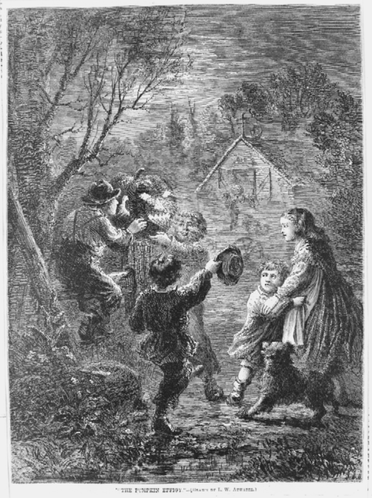|
L.W. Atwater, “The Pumpkin Effigy,” wood engraving, Harper’s Weekly, Nov 23, 1867. Library of Congress, Washington, D.C., LC-USZ62-8391.
|
Jack-O'-LanternThis engraving is probably the first image of a pumpkin jack-o’-lantern, though the article did not describe it as such nor did it mention Halloween. The image appeared alongside the article “A Pumpkin Effigy,” in the November 23, 1867 issue of Harper’s Weekly. By the time of the great Irish migration to North America in the mid-nineteenth century, Americans transformed Halloween from the ancient Celtic fete that commemorated the onset of winter, when souls of the dead walked the earth, into a night of entertainment when spirits appeared as sources of eerie fun and playful conjuring. Halloween night in Victorian America was an excuse for socializing among young adults, a time to recall the magic and mystery of the ancient festivities in a good-humored way. Before this time, the Jack-O’-Lantern, both in the guise of a devilish Irish folk character and an African American spook, had nothing to do with the pumpkin.
|

|
|
- Home
- About the Book
- About the Author
-
Online Exhibition
- Just Another Squash: 12,000 BCE to 1600
- From Pumpkin Beer to Pumpkin Pie: 1600 to 1799
- The Making of a Rural New England Icon: 1800 to 1860
- The Pumpkin and the Nation: 1861 to 1899
- Americans Celebrate the Fall Harvest with Pumpkins: 1900 to 1945
- The Changing Nature of Pumpkins: 1946 to the Present
- The Changing Nature of American Rural Economies: 1946 to the Present
- Events
- Contact

